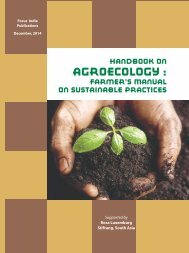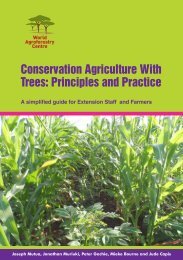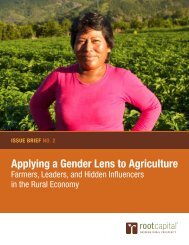1t0SC7l
1t0SC7l
1t0SC7l
Create successful ePaper yourself
Turn your PDF publications into a flip-book with our unique Google optimized e-Paper software.
Hunted animals<br />
Van Dijk (1999) reported a number of 40 mammals as being hunted. The prioritisation of<br />
hunted animals in the present study concerned only the most solicited species and not all<br />
species. Farmers hunting activity is primarily in search of the following animal species:<br />
Atherurus africanus (African bush-tailed porcupine), Cephalophus monticola (Blue duiker),<br />
Cephalophus dorsalis (Bay duiker), Cercopithecus nictitants (Greater white-noosed monkey),<br />
Cercocebus cephus (Moustached monkey) and Cricetomys gambianus (Giant Gambian rat).<br />
Prioritisation and farmers’ reasons of importance for these most solicited species are given in<br />
Table 2.14. Atherurus africanus comes in first position, followed by Cephalophus monticola,<br />
then Cephalophus dorsalis, and in fourth and fifth position, Cercopithecus nictitans /<br />
Cercocebus cephus and Cricetomys gambianus respectively.<br />
Table 2.14. Most solicited hunted animal species.<br />
Scientific name English name<br />
(Bulu name)<br />
Atherurus africanus African bush-tailed<br />
porcupine (Ngom)<br />
Rank<br />
Fr. Cum.<br />
(%)<br />
Reasons of importance<br />
1 41 Increasing local<br />
consumption and diverse<br />
revenues<br />
Cephalophus monticola Blue duiker (Okpweng) 2 33 Increasing local<br />
consumption and diverse<br />
revenues<br />
Cephalophus dorsalis Bay duiker (So) 3 43 Local consumption and<br />
revenues<br />
Cercopithecus nictitans /<br />
Cercocebus cephus<br />
Greater white-noosed<br />
monkey / Moustached<br />
monkey (Evembe / osok)<br />
4 38 High revenues and<br />
consumption;<br />
large solicitations<br />
Cricetomys gambianus Giant Gambian rat (kosi) 5 26 Locale consumption, easy<br />
to capture<br />
2.3.5 Farmers' agricultural production priorities<br />
Priority activities<br />
Crop production remains the first priority activity for all farmers. It is the most important<br />
because the produce of this activity has many destinations: consumption in many forms and<br />
diverse revenues. Animal husbandry was ranked the second priority activity, although just one<br />
third of the farmers ranked it as such. This low figure shows that the activity is somehow<br />
neglected. In third position comes fishing, but the produce is mostly for consumption and very<br />
little is for revenue. In fourth position comes palm wine tapping, which is a permanent source of<br />
consumption and revenue, but the quantity is limited due to the problem of conservation.<br />
Gathering wild fruits comes in fifth position followed by hunting in sixth and oil palm<br />
exploitation in seventh position (Table 2.15).<br />
Table 2.15. Farmers’ priority activities<br />
Major activities Rank Frequency of<br />
ranking (%)<br />
Reasons of importance<br />
Crop production 1 92 Diverse consumption and revenues<br />
Animal husbandry 2 29 Guests reception, dowry, ceremonies<br />
Fishing 3 35 Local consumption, little revenue<br />
Palm wine tapping 4 45 Consumption and unstained revenues<br />
Wild fruits collection 5 22 Seasonal consumption and revenues<br />
Hunting 6 32% Diverse consumption and revenues<br />
Palm oil extraction 7 48 Simple local consumption<br />
Sample size n = 200<br />
23








